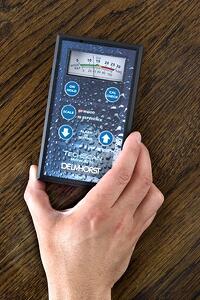 For restoration professionals, the necessity of moisture meters on the job is beyond dispute. With these handy devices, restoration professionals can quickly identify the moisture content of building materials so that they can optimize their restoration efforts and eliminate risk factors for moisture-related damage to a structure.
For restoration professionals, the necessity of moisture meters on the job is beyond dispute. With these handy devices, restoration professionals can quickly identify the moisture content of building materials so that they can optimize their restoration efforts and eliminate risk factors for moisture-related damage to a structure.
For this reason, many restoration professionals keep a pin-type moisture meter in their toolkit when on the job.
However, what about the pinless moisture meter? These workhorse devices are great for restoration professionals to keep around when at work. Here are a couple of reasons why:
#1: Scanning Speed
When it comes to checking for moisture over a large area quickly, pinless moisture meters are your go-to tool. Large, flat building materials are easy to scan by pressing the pinless meter’s scanning plate against the surface, taking a reading, lifting it, and repeating this process over and over until you’ve covered the entire area you needed to scan.
This allows you to identify the presence of moisture pockets in large, flat building materials with ease in a short period of time. By completing such large-area scans quickly, you minimize the time it takes to clear a room, saving labor time on the job.
When moisture pockets are found, you can switch to a pin-type meter to pinpoint the depth at which the moisture pocket occurs using insulated contact pins.
#2: Non-Destructive Scanning
One of the goals of restoration work is to minimize the damage done to the client’s property. By remediating moisture quickly, you can prevent problems such as mold growth or swelling in lumber that can cause damage to said property.
However, with pin meters, you have to punch small holes into building materials in order to get a reading of moisture beneath the surface. Say, for example, the client’s beautiful new hardwood floors. With such large materials, taking measurements only in small, out of the way locations may not be the best idea, as it would be too easy to miss a big moisture pocket in the middle of said floor.
With pinless meters, you can scan almost any flat surface that can accommodate the meter’s scanning plate without leaving a mark. This way, you avoid leaving pinholes in building materials unless it is absolutely necessary.
Just One Tool in the Kit
While pinless meters are invaluable for ensuring quick scanning results, they do not entirely replace pin-type meters as a moisture testing device in restoration work.
For example, in materials that lack a smooth, flat surface to press a pinless meter’s contact plate against, that pinless meter will not be able to take an accurate reading of the material’s moisture content. A pin meter, on the other hand, would not be affected by the fact that the surface of the material is curved or has some other irregular shape.

Also, a pin meter with extended-length probes remains the best way to check for moisture in loosely-packed materials, such as fiberglass insulation. A pinless meter simply cannot get an accurate measure of moisture in such materials.
Yet, when used in conjunction with pin meters, pinless meters can help you save an enormous amount of time when searching for stubborn pockets of moisture during restoration work. With the ability to cover more “ground” in less time, you can do a more thorough check for the presence of moisture deposits in a structure before, during, and after dry-out.
For those restoration professionals who want to keep their tool belts light, using a composite meter with both pin and scanning modes can be a great option. Multi-function devices such as Delmhorst’s Navigator Pro make for convenient building restoration moisture meters, allowing users to quickly switch reading modes for many different situations.
In fact, the Navigator Pro takes convenience to a whole new level by allowing you to store readings and download them into a spreadsheet later using specialized PC software, making it easy to demonstrate that your restoration work is done by showing the moisture measurements you took while on the job.
Learn more about how you can use moisture meters for more effective restoration work today.

Comments